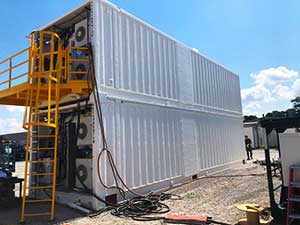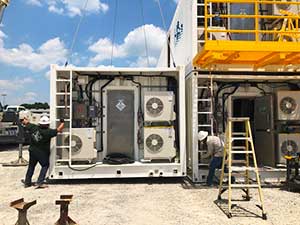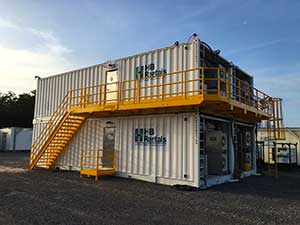Factory Acceptance Test - How It Saves You Time And Money
July 16, 2018
What is a Factory Acceptance Test?
BROUSSARD, La. — For the offshore accommodations market, a Factory Acceptance Test (FAT) is a mock setup of the accommodations modules with the corresponding auxiliary equipment that will connect and tie into the modules. The test is performed at HB Rentals facility and consist of the following:
- All the modules for the project are setup in the exact configuration planned for the offshore installation.
- The auxiliary equipment such as platforms, stairways and cage ladders are connected.
- All equipment and connection points are labeled.
A Company Representative is typically on hand to observe the FAT. During this process, the HB Rentals Supervisor and the Company Representative are looking for any installation issues that might be present by:
- Ensuring that the connection points on the modules interlock to each other properly.
- Checking that the platforms connect into the modules and the stairways/short steps land level to the ground.
- Powering up the modules to verify that all the electrical equipment is functioning properly.
- Testing and calibrating the fire and gas systems to ensure the safety of those working offshore.
- During this time the Company Representative can observe the test, take notes, ask questions on why equipment is being setup certain ways, and what best practices are recommended.
Once the test is completed, the HB Supervisor and Company Representative compile a list of any action items that need to be addressed. A plan is then made and agreed upon to resolve the action items prior to mobilization to the project's location.



Why perform a Factory Acceptance Test onshore prior to sending equipment offshore?
Simple, it will save you time and money by reducing costly modification and installation time offshore. Here's how:
Costly Modifications
By performing the FAT, you are able to see what modifications or changes are needed to the modules and auxiliary equipment prior to mobilization offshore. This allows the modifications to be made at HB Rentals facility which helps to reduce the costs in a couple ways:
- Modifications made onshore at HB’s facility are charged at the onshore service rate versus the high offshore service rate.
- Modifications offshore, which could take up to days to make if certain tools, materials, or tradesman are not already onsite, while modifications onshore would only take several hours at HB Rental's facility, greatly reducing their cost.
Installation Time
The biggest factor in the cost of installing equipment offshore is the labor hours. By performing a factory acceptance test you can significantly reduce the installation time. This is accomplished in a few different ways:
- During the FAT, the equipment is labeled so, once offshore each piece of equipment will be connected exactly as they were at HB’s facility. This streamlines the installation, allowing the installation technicians to work quickly and efficiently, reducing the install time.
- By addressing any modifications prior to the equipment mobilizing offshore, down time during the install that can increase overtime hours is reduced. Any modifications that would be time intensive and could bring the installation to a halt have already been taken care of and the install process moves forward with little to no interruption.
- If the Company Representative on site for the FAT is also the Supervisor overseeing the install offshore, the installation time can be reduced by up to 50%, greatly reducing the labor hours. With the Supervisor having the information gathered from the FAT, they can plan the install based on their notes and best practices to achieve a quick safe installation with the least amount of downtime possible.
Have a question about Factory acceptance test or ways to reduce installation costs? Let us know! We would be happy to help in any way we can:
